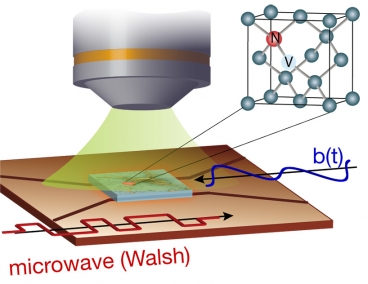Using nanodiamonds to precisely detect neural signals
January 27, 2014

A single nitrogen-vacancy (N-V) center in diamond (right, inset), optically initialized and read out by confocal microscopy, is manipulated with coherent control sequences (red line) of microwave pulses. This measures the arbitrary profile of time-varying magnetic fields radiated by biological sources (or by artificial sources in the researchers’ proof-of-principle experiment). (Credit: Paola Cappellaro)
A team in MIT’s Quantum Engineering Group has developed a new method to noninvasively measure how weak magnetic fields change over time, such as when neurons in the brain transmit signals to each other.
The method uses naturally occurring defects in diamonds called nitrogen-vacancy (N-V) centers, which are sensitive to external magnetic fields, much like compasses
The N-V center defect consists of a nitrogen atom in place of a carbon atom and next to a vacancy — or hollow — within the diamond’s lattice structure.
Noninvasive detection of neural signals
One possibility would be to grow neurons on top of the diamond sensor, to allow it to measure the magnetic fields created by the “action potential,” or signal, they produce and then transmit to other nerves.
Researchers have used electrodes inside the brain to “poke” a neuron and measure the electric field produced. However, this is a very invasive technique, Cappellaro says. “You don’t know if the neuron is still behaving as it would have if you hadn’t done anything,” says Paola Cappellaro, the Esther and Harold Edgerton Associate Professor of Nuclear Science and Engineering (NSE) at MIT..
Instead, the diamond sensor could measure the magnetic field noninvasively. “We could have an array of these defect centers to probe different locations on the neuron, and then you would know how the signal propagates.
The diamond sensors can be used at room temperature, and since they consist entirely of carbon, they could be injected into living cells without causing them any harm, Cappellaro says.
The method could also enable researchers to more precisely measure the magnetic fields produced by novel materials such as the metamaterials used to make superlenses and “invisibility cloaks.
Technical details
To develop the new method of controlling these sensors, Cappellaro’s team first probed the diamond with green laser light until they detected a red light being emitted, which told them exactly where the defect was located.
They then applied a microwave field to the nanoscale sensor, to manipulate the electron spin of the N-V center. This alters the intensity of light emitted by the defect, to a degree that depends not only on the microwave field but also on any external magnetic fields present.
To measure external magnetic fields and how they change over time, the researchers targeted the nanoscale sensor with a microwave pulse, which switched the direction of the N-V center’s electron spin, says team member and NSE graduate student Alexandre Cooper. By applying different series of these pulses, acting as filters — each of which switched the direction of the electron spin a different number of times — the team was able to efficiently collect information about the external magnetic field.
They then applied signal-processing techniques to interpret this information and used it to reconstruct the entire magnetic field. “So we can reconstruct the whole dynamics of this external magnetic field, which gives you more information about the underlying phenomena that is creating the magnetic field itself,” Cappellaro says.
The team used a square of diamond three millimeters in diameter as their sample, but it is possible to use sensors that are only tens of nanometers in size.
In experiments to demonstrate their sensor, the team used a waveguide as an artificial neuron and applied an external magnetic field. When they placed the diamond sensor on the waveguide, they were able to accurately reconstruct the magnetic field.
Mikhail Lukin, a professor of physics at Harvard, says the work demonstrates very nicely the ability to reconstruct time-dependent profiles of weak magnetic fields using a novel magnetic sensor based on quantum manipulation of defects in diamond.
Abstract of Nature Communications paper
Quantum probes can measure time-varying fields with high sensitivity and spatial resolution, enabling the study of biological, material and physical phenomena at the nanometre scale. In particular, nitrogen-vacancy centres in diamond have recently emerged as promising sensors of magnetic and electric fields. Although coherent control techniques have measured the amplitude of constant or oscillating fields, these techniques are not suitable for measuring time-varying fields with unknown dynamics. Here we introduce a coherent acquisition method to accurately reconstruct the temporal profile of time-varying fields using Walsh sequences. These decoupling sequences act as digital filters that efficiently extract spectral coefficients while suppressing decoherence, thus providing improved sensitivity over existing strategies. We experimentally reconstruct the magnetic field radiated by a physical model of a neuron using a single electronic spin in diamond and discuss practical applications. These results will be useful to implement time-resolved magnetic sensing with quantum probes at the nanometre scale.